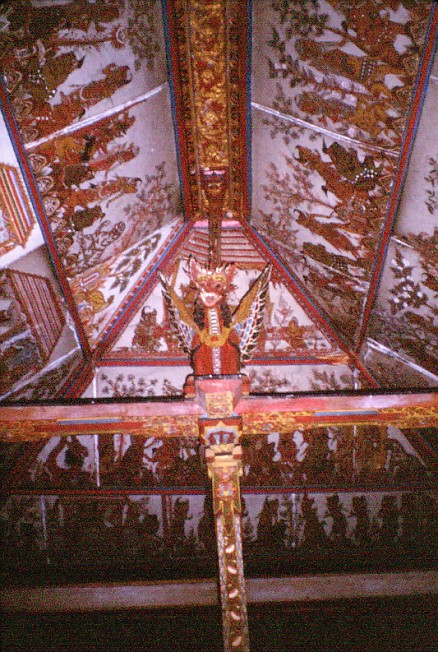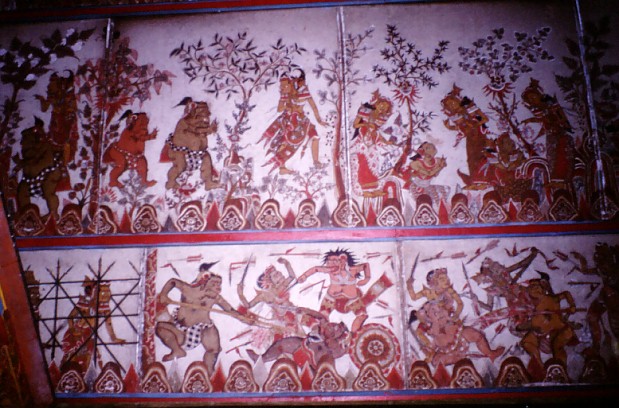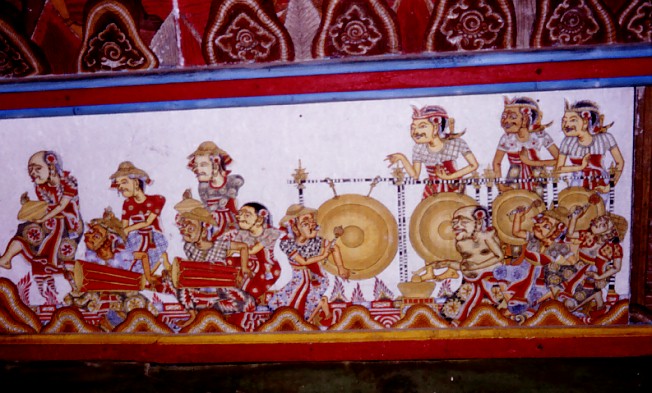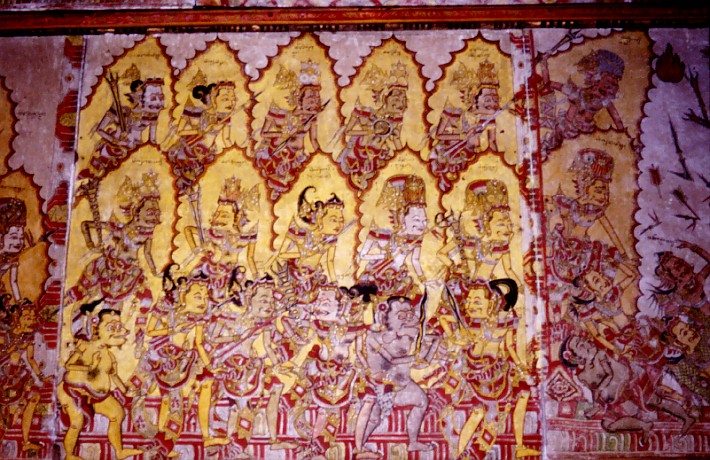|
We had already
seen so much in one day, but even though it was late, Dewa wanted to
make one more stop on the way back to Ubud. He took us to the town of
Klungkung - a "real" town, as Justine said, with shops and
parks and traffic. It's a regional capital and was once home to Bali's
royal families.
|
|
 The thing to see in Klungkung is the Kertha Gosa pavilion with its famous
ceilings painted with scenes from the Bhima Swarga story. The Kertha Gosa
was once the most important bale of the royal palace at Klungkung,
and it was here that the raja and his judges would sit and discuss
matters of law and human affairs. At some point it was decided that the
story of Bhima Swarga, with its moralistic undertones, would be an appropriate
decoration for such a high bale.
The thing to see in Klungkung is the Kertha Gosa pavilion with its famous
ceilings painted with scenes from the Bhima Swarga story. The Kertha Gosa
was once the most important bale of the royal palace at Klungkung,
and it was here that the raja and his judges would sit and discuss
matters of law and human affairs. At some point it was decided that the
story of Bhima Swarga, with its moralistic undertones, would be an appropriate
decoration for such a high bale.
|
|
 The story of Bhima Swarga, which roughly translated means "Bhima
goes to the abode of the gods", is an offshoot from the epic Mahabharata,
and tells of Bhima who is charged by his mother Kunti to rescue the souls
of his father, Pandu and second mother, Madri from Hell and to escort
them to Heaven. You can imagine the kind of visuals the painters came
up with. Nobody is really sure how old the paintings are, but it seems
that they are at least several hundred years old. The painters of the
ceiling were from the village of Kamasan, which we would later visit.
Most of the panels show battles and people meeting grisly ends...
The story of Bhima Swarga, which roughly translated means "Bhima
goes to the abode of the gods", is an offshoot from the epic Mahabharata,
and tells of Bhima who is charged by his mother Kunti to rescue the souls
of his father, Pandu and second mother, Madri from Hell and to escort
them to Heaven. You can imagine the kind of visuals the painters came
up with. Nobody is really sure how old the paintings are, but it seems
that they are at least several hundred years old. The painters of the
ceiling were from the village of Kamasan, which we would later visit.
Most of the panels show battles and people meeting grisly ends...
|
|
 Not all of them, though. We really liked this one showing a gamelan orchestra,
with gongs, two drummers, and a timekeeper. Accompanying Bhima on his
journey are the two ubiquitous servants, Twalen and his son Merdah, who feature
in many of the stories of the Mahabharata. Although these two are
earthy clown characters, they actually show great wisdom, and are in a
way the true heroes of the story. Acting as intermediaries, they interpret
the story to the common Balinese people, and are the characters with whom
the audience most identify. Twalen, the wise clown, is the mascot of our
gamelan in Santa Cruz, and is often depicted on our concert flyers and
programs.
Not all of them, though. We really liked this one showing a gamelan orchestra,
with gongs, two drummers, and a timekeeper. Accompanying Bhima on his
journey are the two ubiquitous servants, Twalen and his son Merdah, who feature
in many of the stories of the Mahabharata. Although these two are
earthy clown characters, they actually show great wisdom, and are in a
way the true heroes of the story. Acting as intermediaries, they interpret
the story to the common Balinese people, and are the characters with whom
the audience most identify. Twalen, the wise clown, is the mascot of our
gamelan in Santa Cruz, and is often depicted on our concert flyers and
programs.
|
|
 Outside the pavilion is a set of moats and walls. Dan is examining the
contents of one of the moats.
Outside the pavilion is a set of moats and walls. Dan is examining the
contents of one of the moats.
|
|
 This looks like another battle shaping up. Even though Bhima has reached
Heaven, he still has to do battle. But here, he and his followers are
depicted as being surrounded by magical energy or sakti, and the
gods, although armed and evidently battling against him, do not attack
him directly, suggesting that in Heaven, war is more psychological and
spiritual, rather than physical and confrontational.
This looks like another battle shaping up. Even though Bhima has reached
Heaven, he still has to do battle. But here, he and his followers are
depicted as being surrounded by magical energy or sakti, and the
gods, although armed and evidently battling against him, do not attack
him directly, suggesting that in Heaven, war is more psychological and
spiritual, rather than physical and confrontational.
|
|
There's an excellent book from which I took some of these notes, called
"Bhima Swarga - The Balinese Journey of the Soul", by Idanna
Pucci (Bulfinch Press), that tells the whole story of the Bhima Swarga,
complete with lots of photos from the Kerta Gosa pavilion.
Dewa had given us a wonderful day - we had seen so much - all for about
$8 each. By the time we got back to Ubud our heads were spinning with
all that we had seen. What a great day! Tomorrow we would take a rest...
|
|
Previous Page | Return
to Index Page | Next Page
Photos: Astrid, Martin and Julia Randall
All content copyright (c) 2002, Astrid, Martin and Julia Randall
|




